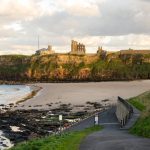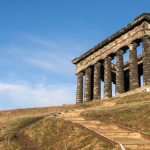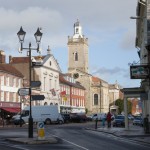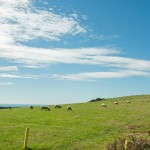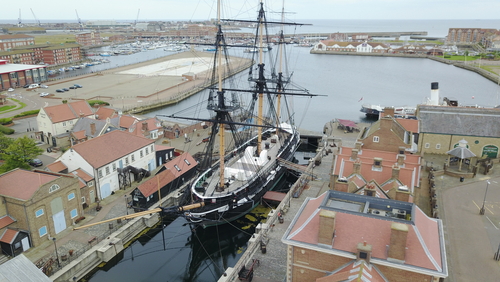
Hartlepool is a Port town in County Durham, north-east England. The town lies on the North Sea coast, about 8 miles (12 km) north of Middlesbrough, and 17 miles (27 km) south of Sunderland. The town comes under the jurisdiction of the Borough of Hartlepool, a unitary authority. Hartlepool is particularly renowned throughout the rest of the country for allegedly executing a monkey during the Napoleonic Wars.
A Fleeting Hartlepool History
Hartlepool derived its name from the Old English for ‘the place where deer (or stags) drink’ i.e. heort (hart), meaning ‘stag’ and pōl (pool), the place where they drink. The first recorded use of the name ‘Hartlepool’ was by the Venerable Bede, the 8th-century Northumbrian theologian and chronicler.
After the collapse of the Roman empire in Britain in the early 5th century, the North East of England was invaded and settled by the Anglo Saxons, who created the influential Kingdom of Northumbria. However, the first known settlement in the Hartlepool area, was in AD 640, when Hartlepool Abbey was founded by an Irish priest, St. Aiden. A fishing village then began to quickly develop around the Abbey.
The monastery enjoyed success under St Hilda, who served as its Abbess between AD 649 and 657. However, that success was relatively fleeting, as the monastery went into decline in the early 8th Century, emulating the demise of the Northumbrian kingdom. The Monastery was eventually destroyed by the marauding Vikings of the 9th century, but the village of Hartlepool survived.
Norman Hartlepool
Following the Norman Conquest of 1066, the De Brus family gained control of Hartlepool and the surrounding land. By 1153, Durham Castle had become the local seat of power, which saw Hartlepool fall under the jurisdiction of Robert de Brus, the 1st Lord of Annandale and Lord of Hartness. By this time, Hartlepool had grown from a mere village to a small, but busy, port. It was during the late 12th century that the Church of St Hilda was built.
In 1201, Hartlepool was granted a borough charter by King John, giving it the right to a weekly market and an annual fair. Throughout the Middle Ages, Hartlepool developed further, growing into an important local market town. One of the main reasons for Hartlepool’s continual economic growth and progression was the fact that it served as the official port for the County of Durham. By this time, Hartlepool had established itself as one of the primary ports on England’s East coast, with fishing also being important to the town.
In 1306, Robert the Bruce was crowned King of Scotland and declared himself the Lord of Hartness. With an expectation of war in the North East, King Edward I, gave the order for Hartlepool’s military defences to be improved. However, in 1315, before they were completed, a Scots army attacked and looted the town.
In the late 15th century, a pier was constructed in the harbour area, which greatly enhanced the town’s port facilities.
The Civil War
In 1642, the onset of the English civil war, saw Hartlepool side with the King against Parliament, along with most of the North. In 1644, a Scottish army, allied to parliament, captured and then occupied Hartlepool. The Scots remained in the town until the beginning of 1647 when they were replaced by English troops.
In 1795, Hartlepool was fortified with defensive measures against the threat of a French attack from Napoleon’s naval forces. Similarly, during the Crimean War, two coastal batteries were constructed in the town, i.e. the Lighthouse Battery in 1855, and Heugh Battery in 1859, to guard against the threat of attacks from the Imperial Russian Navy.
Nineteenth-Century Hartlepool
At the beginning of the 19th century, Hartlepool was still a small town with a population of about 900. By 1831, the town’s population had risen to about 1,300, but to the contrary, the port was no longer busy. Many residents were reliant on fishing for a living. Others were able to make a living on the back of Hartlepool’s newfound status as a spa and holiday resort.
However, plans were afoot by the Council and Board of Trade for Hartlepool to cash in on the town’s strategic location and emerging technology. Construction of new docks was accomplished in 1835, and the railway came to the town in 1839. The railway and the docks made it possible to export coal from the Durham coalfield, through Hartlepool.
As a result, Hartlepool boomed, as shipbuilding and the iron & steel industry also became established in the town. With an influx of new workers, the population of the town had reached 5,236 by 1841. Over the decade, the population again expanded rapidly, growing 76% to 9,227.
In 1847, an indication of the town’s growing success was the opening of a new harbour and dock in West Hartlepool. In 1852, the new Jackson Dock went into service, on the same day that a new railway line opened. The line connected West Hartlepool to Leeds, Manchester and Liverpool.
In 1867, Ralph Ward Jackson was elected to parliament as Hartlepool’s first MP. Ward Jackson Park, located at the west end of Elwick Road in the town, was named in his memory.
Further waterfront improvements in the town, saw the construction of; a breakwater to protect the north harbour in 1870; and a promenade along the seafront, in 1889.
Hartlepool In The 20th Century
By 1901, the population of old Hartlepool (commonly known as ‘the Headland’) was around 14,000, but the new settlement of West Hartlepool’s population was double that, standing at 28,000.
In December 1914, three German ships bombarded Hartlepool, along with Whitby and Scarborough. The bombardment killed 112 people, which included soldiers of the Durham Light Infantry, and injured more than 200 others. In 1921, the event of the first death of British soldiers to die on home soil was commemorated by the opening of the Redheugh War Memorial Gardens.
A plaque marks the spot where the first soldier to die, was killed.
During the Great Depression of the 1930s, Hartlepool suffered particularly badly, enduring high unemployment until the outbreak of WW2 in 1939. During the war, as with much of the North East, Hartlepool’s shipbuilding and steel-making industries enjoyed a revival. However, as a consequence, the town became a target of the German Luftwaffe, who bombed Hartlepool on no less than 43 separate occasions, resulting in a total of 75 fatalities.
Modern Era Hartlepool
After the war, Hartlepool’s heavy industry went into a severe decline. In 1961, after 130 years of shipbuilding, the last ship to be built in Hartlepool, the Blanchland, was launched. The surviving shipbuilder of the era, William Gray and Co., went into liquidation in 1962, with the yards being auctioned off a year later.
In 1967, after several unification efforts, first starting in 1902, the county borough of Hartlepool was formed by the merger of the original borough of Hartlepool (the ‘Headland’) with the borough of West Hartlepool, together with the parish of Seaton Carew.
The 1970s On
In 1970, the Middleton Grange Shopping Centre was opened, providing a major boost to the retailing sector with over 130 new shops, including many of the big high street names. By 1974, most retailers had deserted the old shopping area, centred around Lynn Street. Most of Lynn Street was then demolished to make way for a new housing estate. Only the north end of the street remains, now called Lynn Street North.
In the 1970s, the British economy began to move away from heavy manufacturing, and thus, Hartlepool’s fortunes declined once again. In 1977, the British Steel Corporation announced the closure of its Hartlepool steelworks, with the loss of 1500 jobs. In the 1980’s unemployment in the town peaked at 30%, the highest throughout the country. A total of 10,000 jobs had been lost from the town in the de-industrialization of the UK’s manufacturing heartlands.
During the 1990s, much of the dockland area was redeveloped. The Summerhill Conservation Area was also created. In 1995, Hartlepool Museum opened, Hartlepool Art Gallery in 1996, and the Business Development Centre followed in 1999. New jobs have been found in the service industry, light manufacturing and tourism. New shops have been built and once again has a thriving trade.
The waterfront is now owned by PD Ports, with the docks are still very much capable of handling large vessels. However, a large portion of the former dockland has been converted into the marina, currently capable of berthing up to 500 vessels.
A Little Hartlepool Trivia
Hartlepool is currently twinned with four counterpart overseas towns and cities, i.e. Sète, France; Hückelhoven, Germany; Muskegon, Michigan, USA; and Sliema, Malta.
The population of Hartlepool, at the 2011 census, was recorded as 92,028.
It was also in the early part of the 19th century, during the Napoleonic Wars, that folklore has it, a shipwrecked monkey was hanged by the people of Hartlepool, believing it to be a French spy! To this day, people from Hartlepool are affectionately known as ‘monkey hangers’.
Getting To Hartlepool
Road
Hartlepool is served by two primary routes which are the A179 and the A689 roads, both linking the town to the A19 road. The A179 road is the main road to the north-west which leads to the A19 road, Durham, Sunderland and Tyneside. The A689 road is the main road to the south-west towards the A19 & Billingham, Stockton, Middlesbrough and York.
The A178 road leads south to Seaton Carew, Graythorp, Seal Sands, Port Clarence and Middlesbrough via the Transporter bridge. The A1086 road leads north to Crimdon, Blackhall, Horden, Peterlee and Easington.
Rail
Head for Hartlepool and Seaton Carew railway stations, both of which lie on the Durham Coast Line. There are hourly services from Sunderland, Newcastle and Middlesbrough. The service between London King’s Cross and Sunderland also stops at the town. The journey time to London is around three and a half hours.
Bus
If you’re looking to get out and about, then local bus services around the town are mainly provided by Stagecoach North East. Stagecoach also operates the No. 36 Bus from Hartlepool to Billingham, Stockton and Middlesbrough, and the No. 1 Bus to Middlesbrough via Seaton Carew and Port Clarence. Other services are provided by Arriva North East and Go North East from Hartlepool to Peterlee, Durham, Seaham, Hetton-le-Hole, Houghton-le-Spring and Sunderland.
Places to see
There is a lot more to Hartlepool that you would think. We can’t cover them all but the two below should be high on your list.
St Hilda’s Church
Ward Jackson Park
Ward Jackson Park covers 8.1 hectares and is listed in the National Register of Historic Parks & Gardens, because of its collection of Victorian and Edwardian features, which include the Lodge House (1883), the Bandstand (1901), the Fountain (1902), the Clock tower (1925) and the magnificent Lake set in its Victorian landscape. There’s a children’s play area and there’s often organised events and activities taking place in the park.
Things to do
There are a surprising number of things to do in Hartlepool, a few suggestions are:
National Museum of the Royal Navy
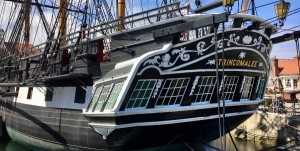
Image: Sarah Weldon/Shutterstock.com
There is an authentically-created historic quayside of the 1800s. The only surviving Royal Navy frigate from the Napoleonic era, the oldest warship still afloat, HMS Trincomalee, is moored alongside. It’s been authentically restored and gives a powerful insight into the tough lives of sailors from around the time of Admiral Lord Nelson. It’s well worth a visit!
The Museum of Hartlepool
The Museum of Hartlepool houses collections that were formerly displayed in the Gray Art Gallery and Museum and the Maritime Museum. The hundreds of exhibits tell the story of Hartlepool, with its rich heritage in shipbuilding, fishing and the sea. The largest exhibit is the fully restored Paddle Steam Ship PS Wingfield Castle.
Built-in 1934, for many years it served as a passenger ferry across the Humber. There is a large number and eclectic mix of other exhibits. You can also find out about Hartlepool’s famous ‘monkey hanging’ legend. There’s also a temporary exhibition area displays local, regional and national exhibitions. There’s more good news – its free entry!
Camerons Brewery
Where to stay?
Indicative prices for the commonly available types of accommodation, in and around Hartlepool, for two people sharing, are as follows:
Luxury Hotel: £80 – £120
Basic Hotel: £45 – £80
Travel Lodge/B & B: £35 – £60
Try The Hartlepool Quiz
Quiz Maker – powered by Riddle
So there you have it our Five Minute Overview of Darlington and a quick quiz to see if you were paying attention! Before you go why not try some of our other quizzes or have a look at some of our other location guides. better still why not join our growing community it’s free and could be very rewarding going forward.

